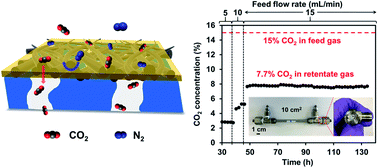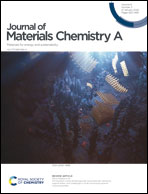Novel carbon-based separation membranes composed of integrated zero- and one-dimensional nanomaterials†
Abstract
The separation membrane structure to a large extent is determined by the membrane building block materials. To explore a new membrane structure, novel materials, including zero- (0D) and one-dimensional (1D) carbon-based materials, were studied in this work as the basic building blocks to fabricate ultrathin, compact separation membranes. Due to the intrinsic difficulty in assembling 0D graphene oxide quantum dots (GOQDs) on porous substrates with much larger pores than the size of the GOQDs and thus low transport resistance, we report for the first time a smart strategy of depositing 1D single-walled carbon nanotubes (SWCNT) as an ultrathin (50 nm) “skeleton” layer to facilitate the assembly/“growth” of 0D nitrogen doped GOQDs to form a densely packed 0D/1D carbon based membrane. This strategy allows evaluation of this new membrane structure composed of 0D and 1D materials as a new membrane configuration for separation applications. The 0D/1D carbon-based membranes were prepared on both hollow fiber and flat sheet substrates (pore size ≥ 25 nm) and characterized to understand the membrane structure, morphology and chemical composition. Carbon capture as a gas separation example and dye removal and desalination as water treatment examples were evaluated to demonstrate the separation potential of the 0D/1D composite carbon membranes. This new membrane structure, along with the facile strategy to form ultrathin, compact coatings, may significantly expand the separation membrane technology field.



 Please wait while we load your content...
Please wait while we load your content...